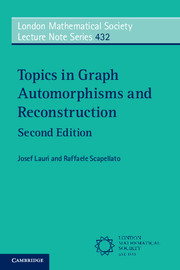Book contents
- Frontmatter
- Dedication
- Contents
- Preface to the Second Edition
- Preface to the First Edition
- 1 Graphs and Groups: Preliminaries
- 2 Various Types of Graph Symmetry
- 3 Cayley Graphs
- 4 Orbital Graphs and Strongly Regular Graphs
- 5 Graphical Regular Representations and Pseudosimilarity
- 6 Products of Graphs
- 7 Special Classes of Vertex-Transitive Graphs and Digraphs
- 8 The Reconstruction Conjectures
- 9 Reconstructing from Subdecks
- 10 Counting Arguments in Vertex-Reconstruction
- 11 Counting Arguments in Edge-Reconstruction
- References
- List of Notations
- Index of Terms and Definitions
9 - Reconstructing from Subdecks
Published online by Cambridge University Press: 05 June 2016
- Frontmatter
- Dedication
- Contents
- Preface to the Second Edition
- Preface to the First Edition
- 1 Graphs and Groups: Preliminaries
- 2 Various Types of Graph Symmetry
- 3 Cayley Graphs
- 4 Orbital Graphs and Strongly Regular Graphs
- 5 Graphical Regular Representations and Pseudosimilarity
- 6 Products of Graphs
- 7 Special Classes of Vertex-Transitive Graphs and Digraphs
- 8 The Reconstruction Conjectures
- 9 Reconstructing from Subdecks
- 10 Counting Arguments in Vertex-Reconstruction
- 11 Counting Arguments in Edge-Reconstruction
- References
- List of Notations
- Index of Terms and Definitions
Summary
Although graph theorists are still very far away from solving the Reconstruction Problem, in most cases where a class of graphs has been shown to be reconstructible it has turned out that only a few of the graphs in the deck were needed. So it seems that, in many cases at least, there might actually be more than sufficient information in D(G) to determine G uniquely. This has prompted many researchers to study variants of the Reconstruction Problem in which only some of the information in D(G) is given. Of course, these problems are more difficult than the original form of the Reconstruction Problem, so there is little hope of solving them in general. But their study has given rise to interesting problems, some of which use theory developed in earlier chapters. We shall consider in the next three sections three such variants of the Reconstruction Problem.
The endvertex-deck
One of the first classes of graphs that was shown to be reconstructible was trees [120]. This early result was subsequently improved so that it was shown that, for any tree T, the endvertex-deck D1(T) consisting of those subgraphs T − v with v an endvertex is sufficient to reconstruct T. One natural question that arises is therefore whether, given a graph G with a sufficiently large number of endvertices, G is endvertex-reconstructible, that is, reconstructible from its endvertex-deck D1(G). Bryant has shown that this is, in fact, not true. His result is a clever use of Bouwer's Theorem and it requires the following lemma, whose easy proof is left as an exercise.
Lemma 9.1Let F = ℤ2be the binary field and let X be the k-dimensional vector space consisting of all k-tuples of elements of F. Let Γ be the group of
permutations that are linear transformations on X. Let A be a basis of X and let B be a set of k vectors of X whose sum is zero but such that any proper subset of B is linearly independent. Then,
Theorem 9.2 (Bryant)For any positive integer k there exists a graph G with k endvertices such that G is not endvertex-reconstructible.
- Type
- Chapter
- Information
- Topics in Graph Automorphisms and Reconstruction , pp. 140 - 148Publisher: Cambridge University PressPrint publication year: 2016

